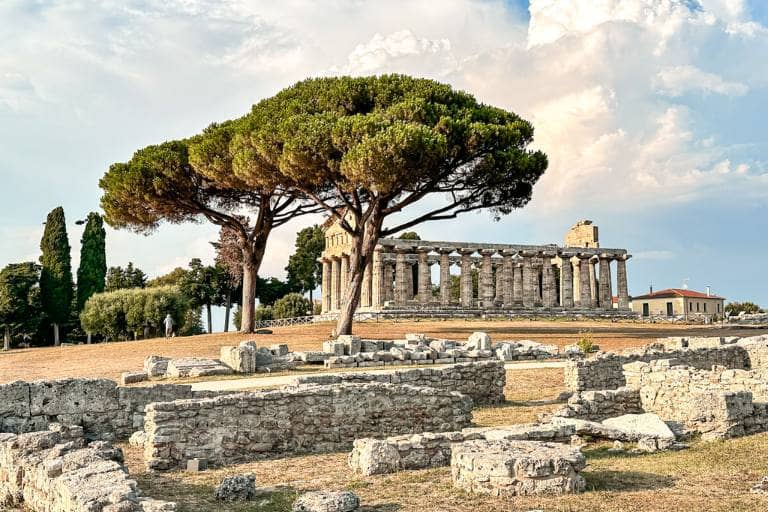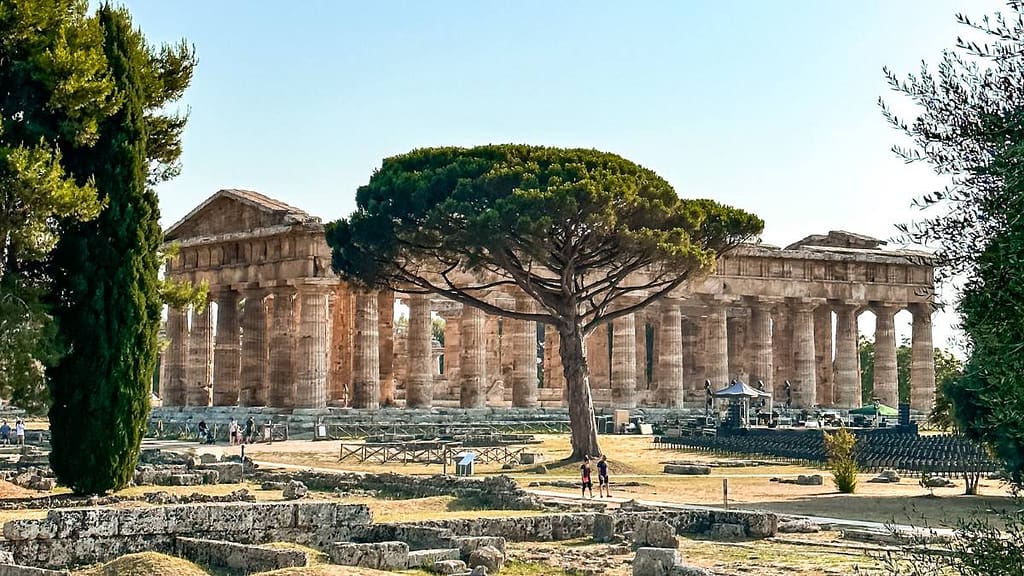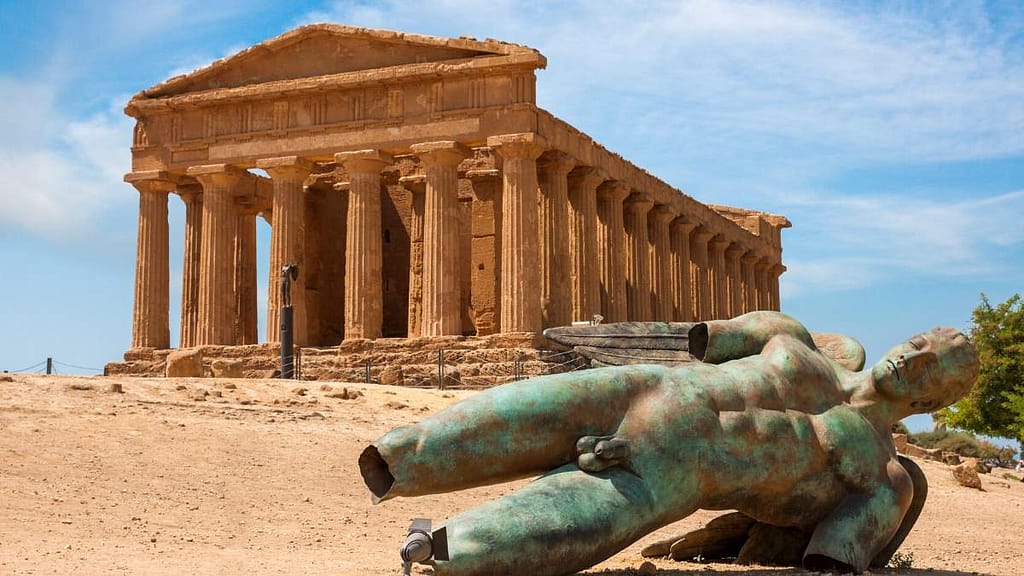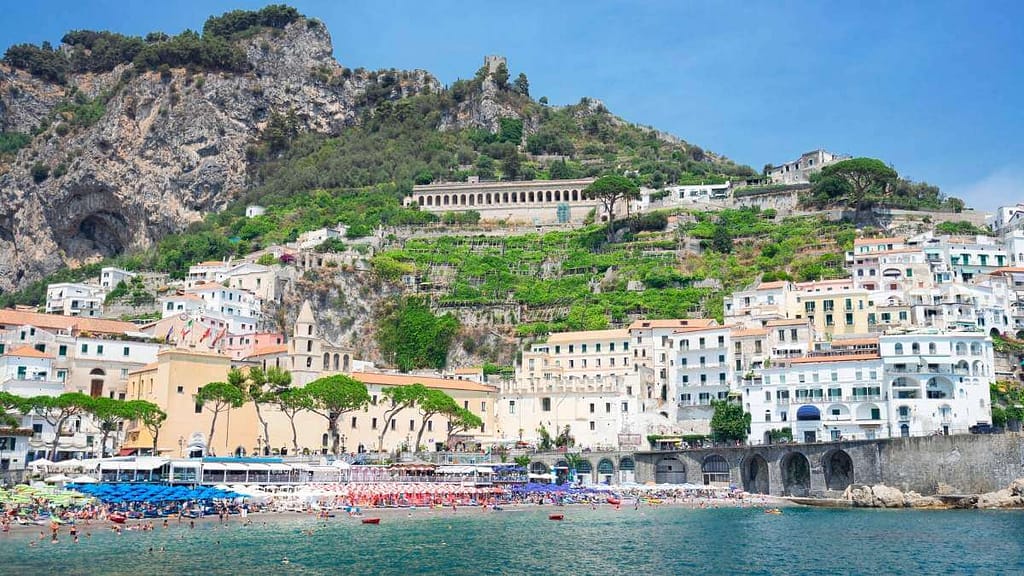Italy is known as a place where you can explore lots of ancient ruins. While Roman or even Etruscan ruins come to mind, you might not think of Italy as a home to ancient Greek ruins. That’s because before the Romans ruled here, this area was ruled by the Ancient Greeks. The stunning three ancient Greek temples at the historic site in Paestum Italy are the great legacy we can admire today.
Paestum is a great place to explore when visiting the Campania region. Not far from Naples and the Amalfi Coast, you can find remnants of this ancient city designated as one of Italy’s many UNESCO World Heritage sites. While we love visiting ruins and temples, the ones at Paestum are one of our favourites. Here is why.
This post may contain compensated links. Find out more info in our DISCLAIMER.
A brief history of Paestum, Italy
Paestum was founded by Greek settlers around 600 BC, and they named it Poseidonia to honour the god Poseidon. Under the Greek occupation, it became a thriving city with the status of an important port in ancient Greece. You can still see the defensive city walls and gates from that time and, of course, the magnificent temples from the classical age.
Poseidonia was eventually conquered by the Lucanians, and by 273 BC, it came under Roman rule. They gave the city its current name and expanded it, as with many other Greek settlements. Today, as you walk along the paved road that is typical of any Roman city, you’ll notice remnants of private buildings as well as those intended for public and religious uses.
After the fall of the Roman Empire, Paestum lost its importance, and eventually, local inhabitants moved to other places. The city was largely abandoned by the early Middle Ages until the mid-18th century. At that time, it became a destination for wealthy aristocrats on their Grand Tour. As rediscovering the wonders of the classical world was all the rage, Paestum got its share of visitors searching for temples, columns and artifacts.

In 1998, Paestum became a UNESCO World Heritage Site. Today, the ancient Greek city of Paestum ruins are one of Europe’s most important archaeological sites. It’s definitely not as popular as Pompeii or Herculaneum, but in our opinion, it’s totally worth seeing.
Visiting Paestum Archaeological Area
The Greek temples of Paestum are considered some of Europe’s most impressive archaeological sites. Considering their age, you can’t help but be impressed by how well-preserved they are. It’s hard to imagine that they still stand for us to explore today.
We first visited Paestum many years ago and have recently returned for another visit. The site still left us in awe. You can’t help but be impressed by these old temples standing seemingly randomly in a field. It’s only after you actually enter the site that you realize there once was a whole city around them.

While the three Greek temples are the main attraction, there is also archaeological evidence of the later Roman period. These include remnants of baths, dwellings, a city wall and the Roman forum, which served as a marketplace for merchants and traders.
There is also an ancient amphitheatre where gladiatorial combat once took place. You can also explore nearby tombs first built by Greek colonists between the 5th and 4th centuries BC.
At first sight, you might not be able to differentiate between the Greek and Roman ruins. Still, if you know anything about how Romans built their cities, it becomes more obvious which ones are which.
The three Greek temples and other ruins
Now. let’s take a closer look at the three temples and all the other important spots to explore at the Paestum Archeological Park.
Temple of Neptune (Poseidon)
Once you enter the site, you’ll see the spectacular Temple of Neptune, also known as the Temple of Poseidon. It’s also been referred to as the Temple of Hera II while others have argued that it was, in fact, dedicated to Apollo, but who really knows? Either way, we felt like it was the most impressive of the three temples at Paestum as it’s also the best-preserved one.

This temple was built by Greek settlers in 530 BC in honour of the god Poseidon. Legend has it that its construction was so ambitious that it caused a drought and famine in the region until Poseidon intervened to restore prosperity to the land. The temple has stood the test of time and still stands today, despite thousands of years since it was built.



The most amazing part (at least for us) is that you can actually walk inside the Temple of Neptune. There is a limit to how many people can enter at the same time, so if you’re there at a busy time, you might have to wait.
Luckily, we didn’t have to, and there weren’t too many people milling around, so we could actually enjoy it. It’s a surreal experience walking on ancient stones, surrounded by magnificent columns and realizing that this place is over 2,000 years old.
Temple of Hera (Juno)
Beside the Temple of Neptune is the oldest of all the three temples at Peastum – the Temple of Hera. Built around 550 BC, it is one of the oldest Greek temples in Europe. What makes it unique is that it’s a bit wider than most Greek temples, with nine columns in the front and 18 columns on the side.


The Temple of Hera has also been mistakenly called a Basilica, as the earlier archaeologists mistook it for a Roman public building. This was later clarified when inscriptions were found clearly stating it was dedicated to Hera, the goddess of fertility and the wife of the mythical Zeus.

You can also enter the temple and admire the details of the Doric columns still standing today. The inside is more open, and you can only walk along one side. It’s still quite impressive and not as busy as its neighbour.
Mimmo Paladino’s Sand Horse
In the field between the Temple of Nepture and the Temple of Hera, you’ll see a horse statue that looks like something you’ll find on an ancient vase. Spoiler – it isn’t that old and was done in 1999 by the artist Mimmo Paladino.
Known as Mimmo Paladino’s ‘Sand Horse,’ the sculpture is made of local sand, iron and resin. This abstract artwork is about 4 metres tall and caused quite a stir when installed in 2019.


While many considered it akin to the desecration of an archeological site, others saw it as a fitting tribute. Poseidon, the one the city was named after, was also the lord of the horses and father of the winged horse Pegasus. We didn’t find it offensive and actually thought it was pretty cool.
The Temple of Athena
The Temple of Athena is another impressive structure built during Greek times. This temple was dedicated to Athena, the goddess of wisdom and justice. It was constructed in 465 BC. Later, it was used as a Christian church between the 7th and 8th centuries AD before being eventually abandoned.

While it was initially thought to be dedicated to Ceres, the Roman goddess of agriculture. However, further discoveries confirmed that it was Athena, not Ceres. The temple’s location, position and statues made it clear that this was a Greek, not Roman, temple.
Unlike the other two temples, you can’t enter the Temple of Athena. Nonetheless, it’s an incredible sight as you come up on it, especially as the sun begins to set.

Roman Amphitheatre
When you visit Peastum, you’ll come across parts of a Roman amphitheatre. From 50 BC, it was used for gladiator fights and public spectacles. Today, the southern half of the stadium, with what used to be the upper seats, is partially visible. The northern half is still underground as it was covered by the construction of the SS 18 Tirrenia Inferiore state road, which crosses the entire archaeological park of Paestum.

The Roman Garden
As gardens were part of Roman spaces, it’s not surprising to find a Roman Garden in the middle of the site. Situated between the Roman forum and the sacredness of the southern sanctuary, the garden was a place where many sacred plants were planted in honour of various gods.

In the middle of what was once filled with olive, laurel and oak trees, you can see the remnants of a semi-circular bench, known as a schola. It was a place for learning, meetings and workshops.
Agora – Ekklesiasterion
In the Greek cities, the agora was the political heart, much like the forum was to the Romans. When visiting Paestum, you’ll come across the round assembly hall called the Ekklesiasterion. You can still see the stone rows of seats where an estimated 1,100 to 1,700 people could sit during political assemblies. The Ekklesiasterion dates to the 5th century BC, and today, it’s a charming spot, especially in the evening.

The Ekklesiasterion
Sanctuary with a pool
When you approach the sanctuary, you can see rows of stone that resemble some type of support for a wooden dock that once stood there. Once you read the plaque, you realize that it was actually a stage, the ancients used for rituals. According to the description, the deity worshipped here was the goddess Venus, known as the turner of hearts.

Apparently, Roman women came to the goddess in hopes of increasing their sensuality and fertility. Every April, there was a celebration called the Veneralia. Roman women gathered here with a wooden statue of Venus where they bathed and then decorated the icon with flowers and jewels. The women then took off their clothes and got in the water together. It was a place where “learning took place and life experiences were exchanged.”
Gates of the walls of the ancient Greek city
In ancient times, Paestum was surrounded by a fortified wall. There are still four access gates, 28 towers and multiple smaller entrances today. One of these gates, the Golden Gate, was demolished when the road was built in 1829. Today, you can still see the four gates – Porta Marina, Porta Aurea, Porta Sirena and Porta Giustizia.

National Archaeological Museum of Paestum
When you visit Paestum, make sure to visit the Paestum Museum. It is home to many items recovered from the site, including funerary objects, pottery, sculptures, cons and many more. Here, you can find rare examples of funerary paintings from the tombs, including one of a young man diving from the early 5th century BC.
The museum is across the street from the site. You have to leave the park to go to the museum. Depending on the weather, you can visit the museum first or leave it after you’ve had an opportunity to explore the ruins.
Practical tips for visiting Paestum Archaeological Park
If you’re planning on visiting the ancient city of Paestum, there are a few practical tips that might come in handy. Bring comfortable walking shoes and plenty of water as you explore the site. Remember to wear sun protection as well, especially during the summer months.
Opening hours Archaeological Area of Paestum
From April to October, the park is open from 8:45 AM to 7:30 PM. During the winter months, from November to March, the opening hours are from 8:45 AM to 5:00 PM.
As for ticket prices, general admission is €9.00 per person. There is a reduced rate of €4.50 for EU citizens aged between 18 and 25 years old. Entry is free for EU citizens under the age of 18 or over 65. Check the official site for more info.
How to get to the Paestum archaeological site
The easiest way to get to the archaeological site is by car. The main entry point is off of the SS18, a coastal highway that runs from Naples to Salerno. There is plenty of space to park your car, and you can even park for free.
There are also buses that run regularly between Paestum and nearby cities such as Agropoli and Salerno. You can also take the Circumvesuviana railway line from Naples to Salerno and then take a bus or taxi from there.
Guided Tours of Paestum Italy and the archaeological park
If you’re looking for an even more immersive experience, we recommend a guided tour of the archaeological site. Tour guides will walk you through the ruins and provide fascinating insight and knowledge about the area’s rich history. You can book a tour on-site, or choose an independently run one. Here are some recommendations:
Small-Group Tour with an Archeologist with Tickets
2-Hour Greek Temples & Archaeological Museum
From Naples: Paestum Day Trip with Mozzarella Tasting
Paestum, Italy, in summary
Paestum is an incredible destination for history buffs, nature lovers and beachgoers alike. Here, you can explore the ancient ruins of Paestum and then enjoy some relaxation at the nearby beaches and national parks.
You can visit Paestum as a day trip, but if you want to make your trip even more memorable, we recommend staying in town or along the beach, especially if you’re there in the summer. You won’t regret it!




